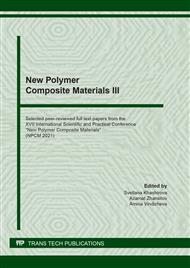[1]
Pengqing Liu, Ting Wu, Guangdou Ye, Jianjun Xu. Novel polyarylates containing aryl ether units: synthesis, characterization and properties. Polymer International. 2013. V. 62, 5. P. 751-758.
DOI: 10.1002/pi.4358
Google Scholar
[2]
Sorokin A.E., Goroshkov M.V., Naumkin A.V., Zyuzina G.F., Solovieva V.A., Krasnov V.P. Influence of the method and processing conditions on the properties of polyarylate. Aviation materials and technologies. 2018. No. 1 (50). - Р. 32-38.
Google Scholar
[3]
Matveev Y.I., Askadskii A.A. The influence of plasticization on the process of dissolution of polyarylate f-1 and polysulfone in some solvents: the role of lyophilic additives. Polymer Science. Series A. 2015. Т. 57. № 1. Р. 1-5.
DOI: 10.1134/s0965545x1501006x
Google Scholar
[4]
Sorokin A.E., Krasnov A.P., Ziuzina G.F., Shcheglov P.A., Afonicheva O.V., Bazhenova V.B., Klabukova L.F. Investigation of the storing process of thermoplastic polyarylate. Plast. Massy. 2013. N 3. P. 51-55 (in Russian).
Google Scholar
[5]
Hongyan Jiang, Yinghua Qi, Tianlu Chen, Shuqin Bo, Mengxian Ding, Lianxun Gao, Jiping Xu, Tianbai He, Yue Zhang. Synthesis, structure and ring‐opening polymerization of phenolphthalein macrocyclic polyarylates. Macromolecular Chemistry and Physics. 2000. V. 201, 17. P. 2385-2393.
DOI: 10.1002/1521-3935(20001101)201:17<2385::aid-macp2385>3.0.co;2-x
Google Scholar
[6]
Xinghua Han, Anne Buyle Padias, H. K. Hall. Syntheses of polyarylates by alcoholysis and esterolysis. Journal of Polymer Science Part A: Polymer Chemistry. 2000. V. 37, 15. P. 2891-2897.
DOI: 10.1002/(sici)1099-0518(19990801)37:15<2891::aid-pola22>3.0.co;2-z
Google Scholar
[7]
Takao Iijima, Takao Kunimi, Toshiyuki Oyama, Masao Tomoi. Modification of cyanate ester resin by soluble polyarylates. Polymer International. 2003. V. 52, 5. P. 773-782.
DOI: 10.1002/pi.1146
Google Scholar
[8]
Zyuzina G.F., Gribova A.A., Krasnov A.P., Slonimskii G.L., Askadskii A.A., Dubrovina L.V., Komarova L.I., Nikolskii O.G. Study of the structure and friction behavior of materials produced from blends of polyarylates and polycarbonates with limited compatibility. J. Frict. Wear. 2000. V. 21. N 2. P. 62-70.
Google Scholar
[9]
Sorokin A.E., Bazhenova V.B., Klabukova L.F., Krasnov A.P. Friction in polymer blends based on DV polyarylate. Usp. Khim. Khim. Tekhnol. MKHT-2013,. 2013. N XXVII. P. 104-108 (in Russian).
Google Scholar
[10]
Nelyub V.A., Borodulin A.S. Properties of epoxy materials used for production of glass-reinforced plastics by the winding method. Polymer Science. Series D. 2018. Т. 11. № 2. рр. 147-153.
DOI: 10.1134/s1995421218020132
Google Scholar
[11]
Ozden S., Kharayev A.M., Bazheva R.Ch. Synthesis and modification of aromatic polyesters with chloroacetyl 3,5-dibromo-p-hydroxybenzoic acid. // J. of Appl. Pol. Sci. V. 111, I. 4, 2009. pp.1755-1762.
DOI: 10.1002/app.29147
Google Scholar
[12]
Kharaev A., Oshroeva R., Bazheva R., Sakhtueva L., Kumykov V., Zaikov G. Synthesis and properties of halogen containing simple and complex block copolyethers. Chemistry and Chemical Technology. 2017. 11. № 2. Р. 166-170.
DOI: 10.1201/b19939-3
Google Scholar
[13]
Patent No 810666 (USSR). Method of obtaining 3,5-dibromo-4-hydroxybenzoic acid / Yasnitskiy B.G., Korobeinikova I.E., Bogun T.A. Publ. 9.04.81. - B.I. No. 9, (1984).
Google Scholar
[14]
Khazaei A., Kazem-Rostami M., Afkhami A., Zare A., Moosavi-Zare A.R., Sadeghpour M. Synthesis, characterization, and application of a triazene-based polysulfone as a dye adsorbent. //Journal of Applied Polymer Science. 2013. V. 129. № 6. pp.3439-3446.
DOI: 10.1002/app.39069
Google Scholar
[15]
Dizman, C. Recent advances in the preparation of functionalized polysulfones / C. Dizman, M. A. Tasdelen, A. Yagci //Polymer International. 2013. Vol. 62, iss. 7. p.991–1007. doi.org/10.1002/pi.4525.
DOI: 10.1002/pi.4525
Google Scholar
[16]
Nelyub V.A., Borodulin A.S. Properties of epoxy materials used for production of glass-reinforced plastics by the winding method. Polymer Science. Series D. 2018. Т. 11. № 2. рр. 147-153.
DOI: 10.1134/s1995421218020132
Google Scholar
[17]
Khairat M. Ibne-Rasa. The Mechanism of Nitrosodecarboxylation of 3,5-Dibromo-4-hydroxybenzoic Acid and Nitrosodeprotonation of 2,6-Dibromophenol. J. Am. Chem. Soc. 1992, 84, 24, 4962–4969.
DOI: 10.1021/ja00883a066
Google Scholar
[18]
Borodulin A.S. Polyester resins for production of goods from polymer composite materials by pressing methods. Polymer Science. Series D. 2013. 6(3). pp.269-270.
DOI: 10.1134/s1995421213030052
Google Scholar


